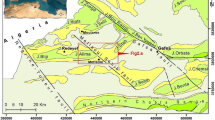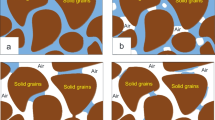Abstract
Frequent occurrence of landslides induced by rainfall or irrigation has seriously threatened the urban and rural development in the Loess Plateau, China. The increase in pore water pressure has been identified as a key factor for understanding wetting-induced loess slopes failures. However, experimental studies are limited regarding the increase in pore water pressure of the collapse loess from an initial negative value until failure occurs under constant total stress condition. An old landslide with progressive retreat development at an early stage of the construction of the Lvliang Airport was selected as a case study. Field surveys including exploration wells and boreholes revealed very fresh sliding shear planes and clearly visible cracks, suggesting the creeping movement of the old landslide. In case of heavy rain or long-term rainfall, this old landslide may be resurrected, threatening the stability of the airport site. To examine the mechanism of the failure induced by wetting for this unsaturated loess landslide, loess specimens were taken from the field, followed by performing a series of laboratory tests, including triaxial shear tests at constant matric suctions and wetting tests at constant deviator stresses. The test results revealed that the wetting-induced deformations of the loess included volume and shear deformations, reflecting compression and shearing behaviour induced by wetting. The failure behaviour of the loess along a wetting path was dependent on the stress level and the loss degree of matric suction as well as the hydro-mechanical path, and could be well described by the linear form of the Mohr-Coulomb strength theory. On this basis, the threshold value of the stress level was identified, which could be used to judge whether the wetting-induced failure of the loess occurs. The threshold value of matric suction at failure was also identified to analyse the loss degree of matric suction from stable conditions to failure. The mechanism of the failure of the soil due to wetting revealed from the present study could interpret the rainfall-induced landslide in unsaturated loess.
















Similar content being viewed by others
References
Brand EW (1981) Some thoughts on rainfall induced slope failures. Proceedings of the 10th International Conference on Soil Mechanics and Foundation Engineering, A.A. Balkema, Brookfield, Vt., pp 373–376
Chen H, Lee CF, Law KT (2004) Causative mechanisms of rainfall-induced fill slope failures. J Geotech Geoenviron 130(6):593–602
Chen CL, Zhang DF, Dong YZ et al (2014) Suction and mechanical behaviours of unsaturated intact loess from constant water content triaxial tests. Chin J Geotech Eng 36(7):1195–1202
Chen CL, Zhang DF, Zhang J, Zhang WB (2017) Compression and wetting deformation behavior of intact loess under isotropic stresses. Chin J Rock Mech Eng 36(7):1736–1747
Chen G, Meng X, Qiao L, Zhang Y, Wang S (2018) Response of a loess landslide to rainfall: observations from a field artificial rainfall experiment in Bailong River basin, China. Landslides 15(5):895–911
Chu J, Leroueil S, Leong WK (2003) Unstable behavior of sand and its implication for slope stability. Can Geotech J 40(5):873–885
Derbyshire E, Meng XM, Kemp RA (1998) Provenance, transport and characteristics of modern aeolian dust in western Gansu Province, China, and interpretation of the quaternary loess record. J Arid Environ 39(3):497–516
Fan XM, Xu Q, Scaringi G et al (2017) A chemo-mechanical insight into the failure mechanism of frequently occurred landslides in the loess plateau, Gansu Province, China. Eng Geol 228:337–345
Farooq K, Orense R, Towhata I (2004) Response of unsaturated sandy soils under constant shear stress drained condition. Soils Found 44(2):1–13
Gallipoli D, Gens A, Sharma R, Vaunat J (2003) A elasto-plastic model for unsaturated soil incorporating the effects of suction and degree of saturation on mechanical behaviour. Geotechnique 53(1):123–135
Gao GR (1988) Formation and development of the structure of collapsing loess in China. Eng Geol 25(2–4):235–245
Hilf JW (1956) An investigation of pore water pressure in compacted cohesive soils. Technical Memo 654, Denver, Bureau of Reclamation
Khalili N, Khabbaz MH (1998) A unique relationship for the determination of the shear strength of unsaturated soils. Geotechnique 48(5):681–687
Lade PV (1993) Initiation of static instability in the submarine Nerlerkberm. Can Geotech J 30(6):895–904
Lin ZG (2008) Loess in China and landslides in loess slopes. Proceedings of the 10th International Symposium on Landslides and Engineered slopes, Xi'an
Lin ZG, Wang SJ (1988) Collapsibility and deformation characteristics of deep-seated loess in China. Eng Geol 25(2–4):271–282
Liu D (1985) Loess and environment. Scientific Press, Beijing
Lourenço SDN, Wang GH, Sassa K, Fukuoka H (2006) Volumetric behavior of saturated sands under poor drainage conditions. J Geophys Res 111(F3):187–201
Maatouk A, Leroueil S, Rochelle P (1995) Yielding and critical state of a collapsible unsaturated silty soil. Geotechnique 45(3):465–477
Nuth M, Laloui L (2008) Effective stress concept in unsaturated soils: clarification and validation of a unified framework. Int J Numer Anal Methods Geomech 32(7):771–801
Oka F, Kodaka T, Suzuki H et al (2010) Experimental study on the behavior of unsaturated compacted silt under triaxial compression. Soils Found 50(1):27–44
Romero E, Vecchia GD, Jommi C (2011) An insight into the water retention properties of compacted clayey soils. Geotechnique 61(4):313–328
Sasitharan S, Robertson PK, Sego DC, Morgenstern NR (1994) State-boundary surface for very loose sand and its practical implications. Can Geotech J 31(3):321–334
Sassa K, Wang G, Fukuoka H (2003) Performing undrained shear tests on saturated sands in a new intelligent type of ring-shear apparatus. Geotech Test J 26(3):257–265
Sorbino G, Nicotera MV (2013) Unsaturated soil mechanics in rainfall-induced flow landslides. Eng Geol 165:105–132
Take WA, Bolton MD, Wong PCP, Yeung FJ (2004) Evaluation of landslide triggering mechanisms in model fill slopes. Landslides 1(3):173–184
Wang NQ, Luo DH (2010) Freezing effect on loess slope and its stability response. J Eng Geol 18(5):103–108
Wang JD, Zhang ZY (1999) A study on the mechanism of high-speed loess landslide induced by earthquake. Chin J Geotech Eng 21(06):670–674
Wang Q, Pufahl DE, Fredlund DG (2002) A study of critical state on an unsaturated silty soil. Can Geotech J 39(1):213–218
Wang GH, Suemine A, Furuya G, Kaibori M, Sassa K (2005) Rainstorm-induced landslides at Kisawa village, Tokushima Prefecture, Japan, August 2004. Landslides 2(3):235–242
Wang GH, Suemine A, Schulz WH (2010) Shear-rate-dependent strength control on the dynamics of rainfall-triggered landslides, Tokushima prefecture, Japan. Earth Surf Process Landf 35(4):407–416
Wang JJ, Liang Y, Zhang HP, Wu Y, Lin X (2014a) A loess landslide induced by excavation and rainfall. Landslides 11(1):141–152
Wang GH, Zhang DX, Furuya G, Yang J (2014b) Pore-pressure generation and fluidization in a loess landslide triggered by the 1920 Haiyuan earthquake, China: a case study. Eng Geol 174:36–45
Wang JD, Gu TF, Xu YJ (2017) Field tests of expansive soil embankment slope deformation under the effect of the rainfall evaporation cycle. Appl Ecol Environ Res 15(3):343–357
Wang JD, Xu YJ, Ma Y, Qiao S, Feng K (2018) Study on the deformation and failure modes of filling slope in loess filling engineering: a case study at a loess mountain airport. Landslides 15(12):2423–2435
Wang JD, Gu TF, Zhang MS, Xu YJ (2019a) Experimental study of loess disintegration characteristics. Earth Surf Process Landf. https://doi.org/10.1002/esp.4575
Wang JD, Li P, Gu Q, Xu YJ, Gu TF (2019b) Changes in tensile strength and microstructure of loess due to vibration. J Asian Earth Sci 169:298–307
Wheeler SL (1988) The undrained shear strength of soils containing large gas bubbles. Geotechnique 38(3):399–413
Xu QJ, Zhang LM (2010) The mechanism of a railway landslide caused by rainfall. Landslides 7(2):149–156
Xu L, Dai FC, Gong QM, Tham LG, Min H (2012) Irrigation-induced loess flow failure in Heifangtai Platform, North-West China. Environ Earth Sci 66(6):1707–1713
Xu L, Dai FC, Tu XB, Tham LG, Zhou YF, Iqbal J (2014) Landslides in a loess platform, North-west China. Landslides 11(6):993–1005
Zhan LT, Chen R, Ng CWW (2014) Wetting-induced softening behavior of an unsaturated expansive clay. Landslides 11(6):1051–1061
Zhang M, Liu J (2010) Controlling factors of loess landslides in western China. Environ Earth Sci 59(8):1671–1680
Zhang DX, Wang GH (2007) Study of the 1920 Haiyuan earthquake-induced landslides in loess (China). Eng Geol 94(1–2):76–88
Zhang ZH, Zhang ZY, Wang YS (1987) Basic geologic problems of loess in China. Acta Geologica Sinica-English Edition 1(2):362–374
Zhang DX, Wang GH, Luo CY, Chen J, Zhou YX (2009) A rapid loess flowslide triggered by irrigation in China. Landslides 6(1):55–60
Zhang FY, Liu G, Chen W, Liang S, Chen R, Han W (2012) Human-induced landslide on a high cut slope: a case of repeated failures due to multi-excavation. J Rock Mech Geotech Eng 4(4):367–374
Zhang FY, Wang G, Kamai T, Chen W, Zhang D, Yang J (2013) Undrained shear behavior of loess saturated with different concentrations of sodium chloride solution. Eng Geol 155(6):69–79
Zhang FY, Pei XJ, Chen WW, Liu G, Liang S (2014) Spatial variation in geotechnical properties and topographic attributes on the different types of shallow landslides in a loess catchment, China. Eur J Environ Civ Eng 18(4):470–488
Zhang FY, Kang C, Chan D, Zhang X, Pei X, Peng J (2017) A study of a flowslide with significant entrainment in loess areas in China. Earth Surf Process Landf 42(14):326–337
Zhao HF, Zhang LM (2014) Instability of saturated and unsaturated coarse granular soils. J Geotech Geoenviron 140(1):25–35
Zhou YF, Tham LG, Yan WM, Dai FC, Xu L (2014) Laboratory study on soil behavior in loess slope subjected to infiltration. Eng Geol 183:31–38
Zhu JH, Anderson SA (1998) Determination of shear strength of Hawaiian residual soil subjected to rainfall-induced landslides. Geotechnique 48(1):73–82
Acknowledgements
The authors want to express their deep thanks to the anonymous reviewers for their constructive comments.
Funding
This study received financial support from research grants no. 41630639 provided by the National Natural Science Foundation of China, no. 2018YFC1504703 provided by the National Key Research and Development Plan, and no. 2018M633559 provided by the Certificate of China Postdoctoral Science Foundation.
Author information
Authors and Affiliations
Corresponding author
Rights and permissions
About this article
Cite this article
Wang, J., Zhang, D., Wang, N. et al. Mechanisms of wetting-induced loess slope failures. Landslides 16, 937–953 (2019). https://doi.org/10.1007/s10346-019-01144-4
Received:
Accepted:
Published:
Issue Date:
DOI: https://doi.org/10.1007/s10346-019-01144-4




